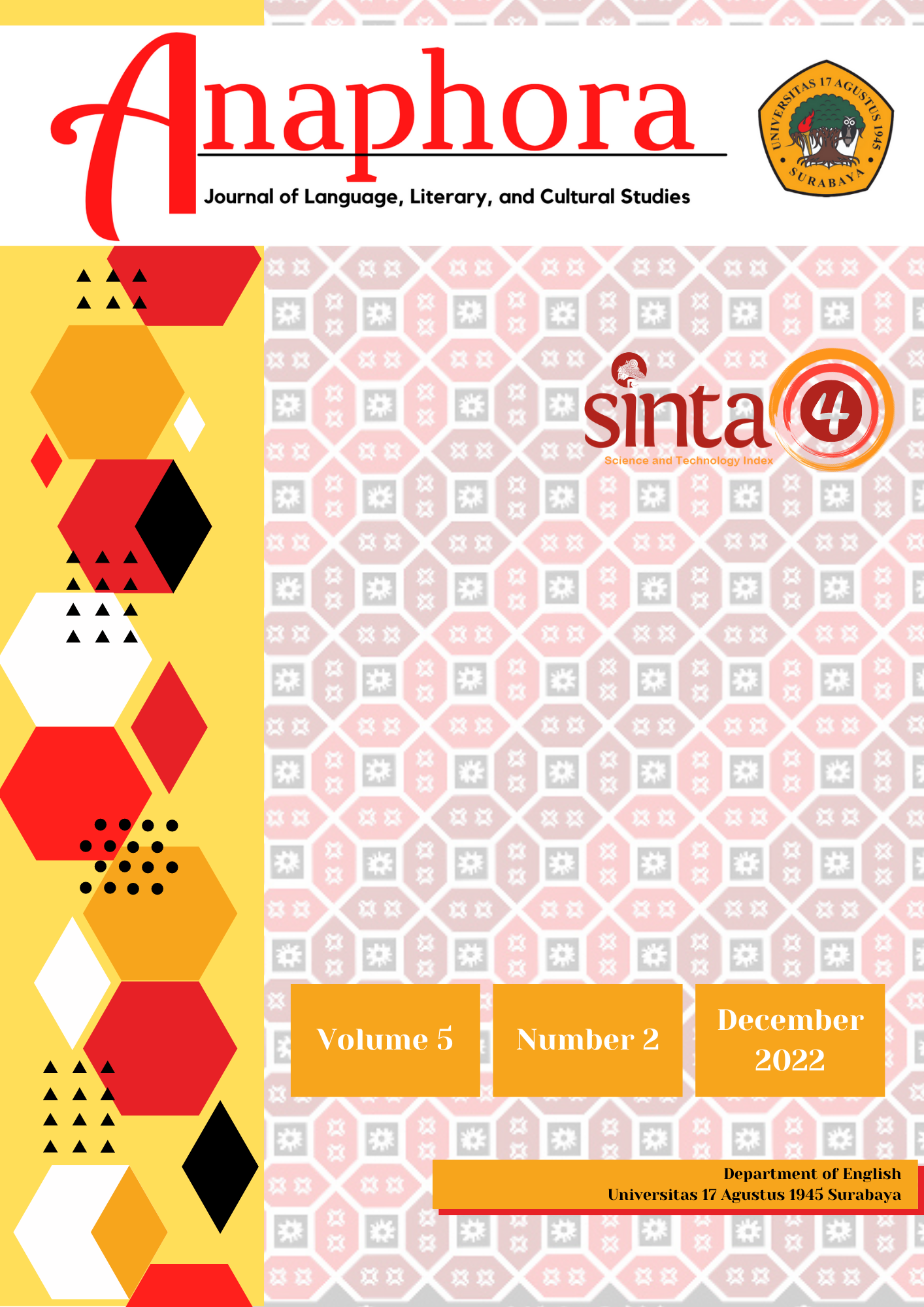Hedging by Raisa on Eric Nam’s Podcast ‘Daebak Show’
Abstract
This research aims to investigate the hedging devices used by Raisa that occurred on Eric Nam’s Podcast Daebak Show Ep.138. It also aims to find out the type of hedging, the meaning of the hedging, and the purpose of using the hedging device by Raisa as a guest star on Eric Nam’s Podcast Daebak Show Ep.138. It is qualitative descriptive research. The object is data from Raisa’s utterances on Eric Nam’s podcast containing lexical hedging in words, phrases, or clauses. In the analysis, the theory used is the theory of taxonomy hedging by Salager-Meyer. The result of this research shows three results. The first result is the type of hedging used by Raisa that consists of five types: 1) modal verbs; 2) adjectival, adverbial, nominal modal verbs; 3) approximators of degree, quantity, frequency, and time; 4) introductory phrases; and 5) “if” clause. The next result is the purpose of hedging by Raisa, who tends to show politeness, make the sentence vaguer and less certain, tone down the force of the statement, and avoid the threatening statement by her addressee. The last result of this research shows how hedging by Raisa means saving her image and her addressee’s image.
Downloads
References
Allo K, B. D. P.., & Nuryanti, D. (2022). The Tenses and Aspects in the Three Novel CoronaVirus-19
Songs. LingPoet: Journal of Linguistics and Literary Research, 3(2), 55-68. Retrieved from https://talenta.usu.ac.id/lingpoet/article/view/8660
Almutairi, M., Kous, N. al, & Zitouni, M. (2022). The Uses and Functions of Barack Obama’s Hedging
Language in Selected Speeches. Eurasian Journal of Applied Linguistics, 8(1), 73–84.
Retrieved from https://doi.org/10.32601/ejal.911520
Azyizah, S. (2021). Code-Switching Used by Putri Tanjung and Boy William in Ngobrol Sore
Semaunya’s Podcast Episode 2. Skripsi S1. Jakarta: Institut Bisnis Nusantara.
Creswell, J. W., & David Creswell, J. (2018). Research Design: Qualitative, Quantitative, and Mixed
Methods Approaches (5th Edition). London: SAGE Publications.
Demir, C. (2018). JOURNAL OF LANGUAGE AND LINGUISTIC STUDIES Hedging and academic writing: an analysis of lexical hedges. In Journal of Language and Linguistic Studies (Vol. 14, Issue 4). Retrieved from www.jlls.org
Florea, S. (2017). Pushed to the hedge: Hedging Devices in Romanian Online Media Discourse on Migration and Refugees (Vol. 18). Retrieved from https://hrcak.srce.hr/file/279075
Fraser, B. (2012). Pragmatic Competence: The Case of Hedging. In G. Kaltenböck, W. Mihatsch, & S. Schneider (Eds.), New Approaches to Hedging: Vol. Vol.9 (pp. 15–34). Brill. Retrieved from https://doi.org/https://doi.org/10.1163/9789004253247
GÖNÜLAL, T. (2020). Improving Listening Skills with Extensive Listening Using Podcasts and Vodcasts. International Journal of Contemporary Educational Research. Retrieved from https://doi.org/10.33200/ijcer.685196
Hyland, K. (1998). Hedging in Scientific Research Articles (A. H. Jucker, Ed.). John Benjamins Publishing Company.
Ilmiyah, D. R. (2019). HEDGING USED BY THE WRITER IN NEW YORK TIMES ONLINE WEBSITE [Universitas Islam Negeri Maulana Malik Ibrahim]. Retrieved from http://etheses.uin-malang.ac.id/id/eprint/16488
Imarshan, I. (2021). Popularitas Podcast Sebagai Pilihan Sumber Informasi Masyarakat Sejak Pandemi COVID-19. Perspektif Komunikasi: Jurnal Ilmu Komunikasi Politik Dan Komunikasi Bisnis, 5(2), 213–221. Retrieved from https://jurnal.umj.ac.id/index.php/perspektif/article/view/12212
Istanto, J. W., & Indrianti, I. (2011). Pelangi Bahasa Indonesia Podcast: What, Why and How? Electronic Journal of Foreign Language Teaching, 8(1), 371–384. Retrieved from http://e-flt.nus.edu.sg/
Llinares, D., Berry, R., & Fox, N. (2018). Podcasting: New Aural Cultures and Digital Media. In Podcasting: New Aural Cultures and Digital Media. Palgrave Macmillan. Retrieved from https://doi.org/10.1007/978-3-319-90056-8
Mauranen, A. (2011). They’re Little Bit Different... Observations on Hedges in Academic Talk. In Discourse Patterns in Spoken and Written Corpora (pp. 173–197). Retrieved from https://doi.org/10.1075/pbns.120.12mau
Mulatsih, S. (2008). HEDGES: THE EXPRESSIONS OF DOUBT AND CERTAINTY. LITE Jurnal Bahasa, Sastra, Dan Budaya Universitas Dian Nuswantoro, Vol. 4(No.2), 73–81. Retrieved from https://doi.org/https://doi.org/10.33633/lite.v4i2.446
Namsaraev, V. (2010). Hedging in Russian Academic Writing in Sociological Texts. In R. Markkanen & H. Schröder (Eds.), Hedging and Discourse: Approaches to the Analysis of a Pragmatic Phenomenon in Academic Texts (pp. 64–80). De Gruyter. Retrieved from https://doi.org/https://doi.org/10.1515/9783110807332.64
Nozawa, Y. (2015). The Use of Hedges in Polite Disagreement by Japanese Advanced Learners of English. Retrieved from https://core.ac.uk/download/pdf/286927795.pdf
Nuryanti, D. (2019). Showing Emotion of Surprise Using Metaphorical Expression by Arabic Descendent Community. Esensi Lingua, 1(1). Retrieved from https://ibn.e-journal.id/index.php/LINGUA/article/view/151
Quaglio, P. (2009). Television Dialogue: The sitcom Friends vs. natural conversation. In Studies in Corpus Linguistics: Vol. Volume 36. Amsterdam: John Benjamins Pub. Co.
Riekkinen, N. (2009). SOFTENING CRITICISM: THE USE OF LEXICAL HEDGES IN ACADEMIC SPOKEN INTERACTION. Helsinki: University of Helsinki
Rosanti, E. D., & Jaelani, A. (2016). The Use of Lexical Hedges in Spoken Language by Female and Male Students. English Journal of UIKA Bogor, 9(No.1), 29–39. Retrieved from https://doi.org/http://dx.doi.org/10.32832/english.v9i1.251
Salager-Meyer, F. (2011). Scientific discourse and contrastive linguistics: Hedging. European Science Editing, 37(2), 35–37.
Sugiyono, S. (2013). Metode Penelitian Kuantitatif, Kualitatif Dan R&D. Bandung: ALFABETA, CV.
Sunendar, N. F., Sudana, D., & Gunawan, W. (2020). Analysis of Lexical Hedges: Sociopragmatic of Representative Speech Act of Main Woman Character in Sweet 20 Movie. 3rd International Conference on Language, Literature, Culture, and Education (ICOLLITE 2019).
Yin, R. K. (2014). Case Study Research: Design and Methods (5th Edition). SAGE Publications, Inc.
Yule, G. (2011). The Study of Language Fourth Edition (4th Ed.). Cambridge: Cambridge University Press.
Zakia, A. (2018). Pragmatic Study On Hedging As Politeness Strategy in Online Newspaper. Jakarta: State Islamic University Syarif Hidayatullah. Retrieved from https://repository.uinjkt.ac.id/dspace/bitstream/123456789/45815/1/ANISA%20ZAKIA-FAH.pdf
Copyright (c) 2022 Salca Pragita, Dewi Nuryanti

This work is licensed under a Creative Commons Attribution-ShareAlike 4.0 International License.
Authors whose manuscript is published will approve the following provisions:
-
The right to publication of all journal material published on the jurnal anaphora website is held by the editorial board with the author's knowledge (moral rights remain the property of the author).
-
The formal legal provisions for access to digital articles of this electronic journal are subject to the terms of the Creative Commons Attribution-ShareAlike (CC BY-SA) license, which means Jurnal Persona reserves the right to store, modify the format, administer in database, maintain and publish articles without requesting permission from the Author as long as it keeps the Author's name as the owner of Copyright.
-
Printed and electronic published manuscripts are open access for educational, research and library purposes. In addition to these objectives, the editorial board shall not be liable for violations of copyright law.




